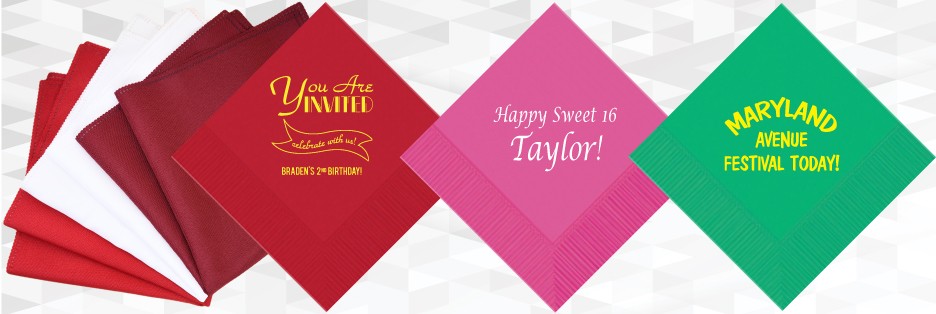
Why Are Napkins Called Napkins. Full Story of Napkins

Discover the history of napkins, where you will learn about the origin, application, and manufacture of napkins.
History of Napkins: The Evolution From Cloth to Paper
Today napkins are a functional staple in the kitchen, made from regular factory cloth or recycled paper. In past centuries, napkins were used not only for cleansing hands — they were works of art, articles to dress up the table, elaborate objects to elevate the dining ceremony.
Some researchers give credit to Da Vinci for inventing the napkin as he showed a strong passion in developing dining etiquette. However, throughout history, a napkin evolution received a variety of contributions from different countries and cultures.
In the United States, the napkin is folded and placed to the left of the forks or on the center of the place setting. In Europe, the napkin is often placed on the right of the place setting. At a formal dinner, the napkin is usually folded into more elaborate shapes using origami 3D building techniques.
Napkin: Etymology and Worldwide Use of Word
A napkin, linen, diaper, face towelette, or serviette is a cloth used at a meal to clean the mouth and fingers while eating to protect garments, or to place meals on. The word “napkin” originates from Middle English, derived from Old French “nappe” meaning a “tablecloth” and adding the suffix -kin.
A napkin is an American English word. A serviette is used outside of the US, in some parts of the United Kingdom, Canada, Australia. It is functionally the same as a napkin, made either of cloth or paper, and used mostly for cocktail receptions, for meals eaten when standing up, etc.
Types of Napkins
Today cloth napkins are manufactured in a plethora of patterns, colors, and fabrics. Solid white, black, and ivory are the most conventional options. White is still considered to exude the most elegance. Monograms can be incorporated to further personalize the event. Napkins are most often made of cotton, basic linen, or cotton-linen blends. Paper napkins come in an even wider selection of styles, patterns, colors, and quality.
Sizing is another choice to make when purchasing napkins. Small five-inch cloths are suitable for afternoon tea, cocktail drinks, buffet-style meals, and hors d'oeuvres. Eight to twelve-inch napkins—the only type of rectangular shape —are perfect for lunch. Informal and formal full course dinner napkins are square, ranging from 18 to 24 inches.
The best way to demonstrate your enthusiasm about a special event such as a wedding, baby shower, and everything in between is to order personalized napkins. Their unique appearance makes a great way to mark and celebrate any event.
Napkins: Origin and History
Historical accounts of napkins recorded that the ancient Spartans in Greece commonly used soft lumps of bread to clean off their hands. Textual evidence is found in Alciphron's letter and in Aristophanes' play. The edible substance in both texts is called “apomagdalia”, a loaf of bread broken up into small pieces, then rolled at the table. This custom led later on to clean off hands with sliced bread.
Roman antiquity introduced two sizes of cloth for napkin-assigned purposes—the sudarium, a smaller size cloth, sort of “a sweat cloth” to blot the face in the hot Mediterranean weather—and the mappa, a larger colorfully embroidered linen, to cover lengthwise the edge of the sofa while feasting in a reclining position.
Paper, which production originated in central China in the 2nd century CE, found its use as napkins as well. Paper was folded into squares and placed at the bottom of a tea serving basket.
In the early Medieval Period, the cloth napkin vanished from the tables and people began wiping hands with whatever was around.
Throughout the Renaissance, napkins made a major comeback. The transformation of a napkin from "folded cloth to folded art" took place in Florence, in the 16th century. A napkin had gone from a cloth spread on the table to an ornament, a ceremonial object, an elaborate fabric hung over the arm of a servant, adding formality and elegance to the setting. The French court introduced intricate codes of etiquette for the nobility, among them the napkin rules.
The very first references to napkins in England go back to 1384. By the16th century, napkins became an accepted object of refined dining. The diaper, an English word for white textile, from medieval Greek diaspros, was manufactured of white linen in a diamond shape. A larger size napkin was called “serviette”. A smaller napkin used in a way similar to today cocktail napkins was called “serviette de collation”. A “touaille” was a linen roll draped around a tube of wood and used for drying hands.
However, the introduction of a fork in the 17th century and emphasis on fine dining became a turning point for the use of napkins. Forks came to England from Italy. A napkin became a less essential item in dining.
In regards to paper napkins, those didn’t develop as an industry until the end of the 19th century. Napkins made of paper were regarded as a mauvais ton in social settings. Over time the product improved and its convenience was acknowledged. A major breakthrough happened in 1948 when Emily Post, America’s etiquette authority, gave paper napkins her endorsement. Of course, paper napkins have a major advantage over cloth ones—they’re disposable and less expensive. Top-quality paper napkins are available and can be put to use on even formal occasions.
Today the latest trend highlights the fact that millennials see paper towels as a better alternative for paper napkins.
Summary
If you look retrospectively, the people have constantly been changing their napkin preferences and habits. Whatever started as edible lumps of bread, moved to large tablecloths for communal use, then transformed into ornamental elaborate objects for individual use at the fine ceremonial dining, and eventually became disposable pieces of multipurpose paper.

Leave a Comment